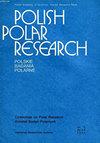Temporal and spatial variability of thermal and humidity stimuli in the Hornsund area (Svalbard)
IF 0.8
4区 地球科学
Q4 ECOLOGY
引用次数: 7
Abstract
The article presents the biometeorological impact of thermal and humidity conditions on the human body in the Hornsund area in the southern Spitsbergen, Svalbard. This was determined based on diurnal air temperature range, the day-to-day variation in average diurnal air temperature and the average diurnal relative humidity. The temporal variability of thermal and humidity biometeorological stimuli in Hornsund was examined for the period 01.11.1978–31.12.2017. A lessening of biometeorological impact was found in the southern Spitsbergen region, including a statistically significant negative trend in stronglyand severely-felt stimuli (according to diurnal air temperature range), and in significant and severe stimuli (according to day-to-day variation in average diurnal air temperature). A non-significant positive trend was observed in the number of days of relative humidity with humid and very humid air. To analyse the spatial variability of the stimuli around the Hornsund fjord, data were used from seven year-round measuring stations for the period 01.07.2014–31.06.2015. The most unfavourable conditions were found on the Hans Glacier, on the summit of Fugleberget and inside the fjord. The paper presents the role of atmospheric circulation on thermal and humidity stimuli. In the Hornsund region, the highest probability of unfavourable sensible temperatures for humans occurring during the year was mostly in winter and early spring. This was related to the advection of air masses from the north-east sector, regardless of baric regime type. It was found that very humid air (> 85%) flowed over Hornsund for practically the entire year from the S–SW as part of both cyclonic and anti-cyclonic systems.霍恩松德地区(斯瓦尔巴群岛)热湿度刺激的时空变异性
本文章由计算机程序翻译,如有差异,请以英文原文为准。
求助全文
约1分钟内获得全文
求助全文
来源期刊

Polish Polar Research
ECOLOGY-GEOSCIENCES, MULTIDISCIPLINARY
CiteScore
2.00
自引率
7.70%
发文量
0
审稿时长
>12 weeks
期刊介绍:
The quarterly Polish Polar Research edited by the Committee on Polar Research of the Polish Academy of Sciences is an international journal publishing original research articles presenting the results of studies carried out in polar regions.
All papers are peer-reviewed and published in English.
The Editorial Advisory Board includes renowned scientist from Poland and from abroad.
 求助内容:
求助内容: 应助结果提醒方式:
应助结果提醒方式:


